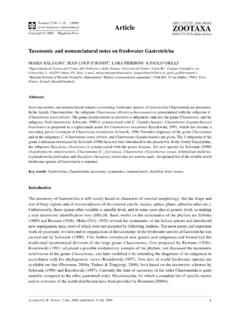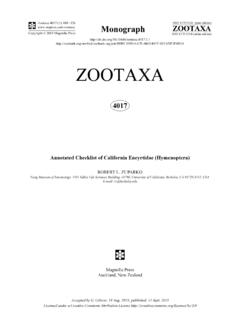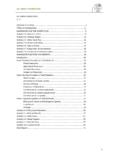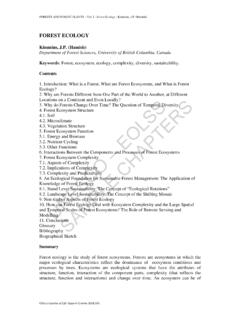Transcription of 3948 (2): 233 247 www.mapress.comzootaxa Article ZOOTAXA
1 Accepted by R. Pethiyagoda: 23 Mar. 2015; published: 21 Apr. 2015 Licensed under a Creative Commons Attribution License 1175-5326 (print edition)ISSN 1175-5334 (online edition)Copyright 2015 Magnolia PressZootaxa 3948 (2): 233 247 233 : :pub:AF652D3A-05D0-4781-86A7-0813B4CE8E4 7 Description of Danio absconditus, new species , and redescription of Danio feegradei (Teleostei: Cyprinidae), from the Rakhine Yoma hotspotin south-western MyanmarSVEN O. KULLANDER1 & RALF BRITZ21 Department of Zoology, Swedish Museum of Natural History, PO Box 50007, SE-104 05 Stockholm, Sweden. E-mail: of Zoology, The Natural History Museum, Cromwell Road, London, SW75BD, United Kingdom. E-mail: feegradei Hora is redescribed based on recently collected specimens from small coastal streams on the western slope of the Rakhine Yoma, ranging from the Thade River drainage southward to slightly north of Kyeintali.
2 Danio ab-sconditus, new species , is described from the Kyeintali Chaung and small coastal streams near Gwa, south of the range of D. feegradei. Both species are distinguished from other Danio by the presence of a dark, elongate or round spot at the base of the caudal fin and a cleithral marking composed of a small black spot margined by a much smaller orange spot. Danio feegradei is characterized by the colour pattern, with series of white spots along the otherwise dark side; D. absconditusby about 7 11 dark vertical bars on the abdominal side. Within Danio, the presence of a complete lateral line, cleithral spot, and 14 circumpeduncular scales is shared with D. dangila and similar species , but these character states may be ple-siomorphic as suggested by the shared presence of cleithral spot and complete lateral line in Devario and Betadevario.
3 In other Danio the cleithral spot is absent, the lateral line is short or absent, and the circumpeduncular scale count is lower (10 12). Twenty teleost species are reported from streams on the western slope of the Rakhine Yoma, all probably endem-ic. The parapatric distribution of D. absconditus and D. feegradei is unique within the genus, and may be partly explained by changes in eustatic sea levels. Key words: colour pattern, freshwater fish, morphology, species discrimination, taxonomy IntroductionMany recent papers have contributed to show that the short coastal streams of the western slope of the Rakhine Yoma mountain range in south-western Myanmar harbour a rich and highly endemic fish fauna ( , Britz, 2007, 2010; Conway & Kottelat, 2010; Kullander, 2015; Kullander & Fang, 2004, 2009a; Ng, 2004).
4 Still, only a fraction of the region has been surveyed and many species await description. Danio feegradei is one component of this endemic fauna. It was described by Hora (1937) on the basis of a single specimen from road-side drains in Sandoway (now Thandwe). There are no later collections of D. feegradei reported, although it has become available in the ornamental fish trade (Cottle, 2010), and aquarium specimens have been used in phylogenetic analyses ( , Collins et al., 2012; Tang et al., 2010). Barman (1991) considered D. feegradei to be a synonym of D. dangila (Hamilton), but recent taxonomic papers consider it as valid (Fang Kullander, 2001; Kottelat, 2013). In this paper we provide a revised diagnosis of D. feegradei, demonstrating its distinctness on the basis of recent collections.
5 We also present evidence that a similar, undescribed species , sharing unique colour-pattern characters, is present on the western slope of the Rakhine Yoma. The two species are almost overlapping in distribution, presenting a rare example of parapatry between putative sister species , further underlining the importance of the coast of western Myanmar as a hotspot for fish & BRITZ234 ZOOTAXA 3948 (2) 2015 Magnolia PressMaterial and methodsSpecimens are kept in the fish collections of the Swedish Museum of Natural History, Stockholm (NRM), the Natural History Museum, London (BMNH), and the Zoological Survey of India, Kolkata (ZSI). Measurements were taken with digital callipers to a precision of mm. Counts and measurements were made according to Fang (1997), except that the last unbranched ray in the dorsal and anal fins, which articulates with the same pterygiophore as the branched ray preceding it, is designated as a half-ray ( ), and body depth is measured at the origin of the dorsal fin instead of at the origin of the pelvic fin.
6 Colour-pattern terminology follows Fang (1998), with the modifications in Kullander (2015). When present, horizontal dark stripes and light interstripes are identified by alphanumeric annotations: the P stripe is the dark stripe along the middle of the side, those above are numbered P+1, P+2, those below P-1, P-2, P-3. With the same method interstripes are termed I (between P and P+1) and I+n dorsally and I-n ventrally. The interstripe Ia is a short interstripe dividing the P stripe anteriorly. Stripes on the anal fin are numbered with the middle one the A stripe, the proximal stripe A+1, and the distal stripe A-1, and stripes on the dorsal fin correspondingly. Fin-ray counts from pectoral and, pelvic fins were obtained directly from the specimens under a dissection microscope and with transmitted light.
7 Fin-ray counts from the dorsal, anal, and caudal fin, and vertebral counts were taken from X-radiographs made with a Philips MG-105 low voltage X-ray unit and Kodak X-Omat V plates. Abdominal vertebrae counts include the Weberian apparatus (assumed to contain four centra). Values in parentheses after a count represent the frequency of that count. Statistics were calculated using SYSTAT v. 13 (Systat Software, 2009), except that the principal component analysis (PCA) of measurements was made using a separate procedure for component shearing, partialling out multivariate size residues from the second and further components as described by Humphries et al. (1981). The PCA was made with log-transformed measurement data to tenth of a millimetre in a covariance matrix, and without rotation.
8 Comparative material. Material of Danio Hamilton listed in Fang (1998), Kullander (2012, 2015), Kullander & Fang (2009 a, b), and Kullander et al. (2009).Danio feegradei Hora, 1937(Figs. 1 4)Material examined. All from Myanmar, Rakhine State. BMNH 28, 17, mm SL; NRM 66246, 5, mm SL. South stream Daung Chaung, 18 2'17"N, 94 30 26 E. 1 Dec 2009, R. Britz. BMNH 58, 52, mm SL. Delmound Chaung,18 46 42 N, 94 17 6 E. 27 Nov 2009, R. Britz. BMNH , 1, mm SL. Chaung Ma Gyi Chaung Leldee village, 18 35 7 N, 94 22 11 E. 28 Nov 2009, R. Britz. BMNH 99, 38, mm SL; BMNH 177, 7, mm SL. Three different sites along Thandwe Chaung, 18 24 33 N, 94 28 46 E. 29 Nov 2009, R. Britz. BMNH 128, 29, mm SL. Ka Din Lay Chaung, 18 18 39 N, 94 27 51 E.
9 30 Nov 2009, R. Britz. BMNH 144, 7, North stream Kyauk Tan village, 18 2 40 N, 94 29 39 E. 1 Dec 2009, R. Britz. NRM 45660, 1, mm SL. Thade River drainage: Yan Khaw Chaung, ca 4 km on logging road from Gwetauk village, 23 km on road Taunggok-Pyay, 18 47 48 N, 94 21 46 E. 21 Mar 1998, S. O. Kullander & R. Britz. ZSI F. 12477/1. Holotype, mm SL, Sandoway (=Thandwe). Jun Aug 1936, E. S. Feegrade (Photograph only).Diagnosis. Distinguished from all other species of Danio except D. absconditus by the presence of a large, elongate black spot at the base of the caudal fin (vs. absence; or minute and inconspicuous in D. jaintianensis(Dey), D. choprae Hora and D. flagrans Kullander; or small, round and margined by a lighter zone in D. erythromicron (Annandale)), a small black or grey cleithral spot and a light (orange in life) spot immediately above the cleithral spot (vs.)
10 Absent; or present, large and not bordered by light spot in D. assamila Kullander, D. catenatusKullander, D. concatenatus Kullander, D. dangila, and D. sysphigmatus Kullander; or minute, not separated from P stripe and not associated with light spot in D. meghalayensis Sen & Dey). Distinguished from all Danio except D. absconditus, D. assamila, D. catenatus, D. concatenatus, D. dangila, D. meghalayensis and D. sysphigmatus by the presence of a complete lateral line (vs. abbreviated or absent) and 14 16 circumpeduncular scales (vs. 10 12). Distinguished from D. absconditus by absence of dark vertical bars on abdominal sides (vs. presence of about 7 11 distinct dark bars), and presence of a dark area along the middle of the side, with two or three irregular horizontal rows of white dots (vs.









